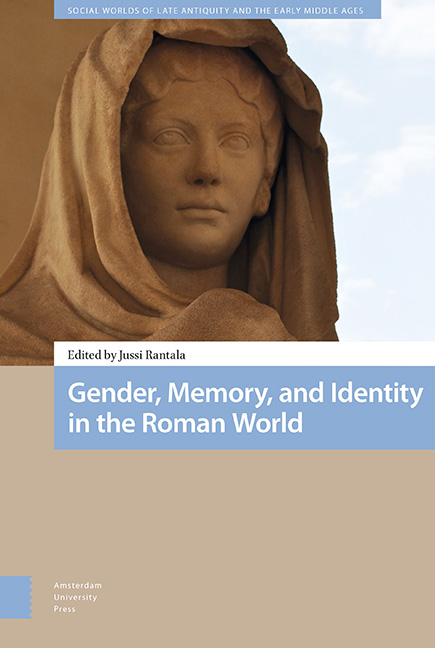Book contents
- Frontmatter
- Contents
- List of Illustrations
- Abbreviations
- Preface
- Tabula Gratulatoria
- Introduction
- 1 Public Agency of Women in the Later Roman World
- 2 Religious Agency and Civic Identity of Women in Ancient Ostia
- 3 The Invisible Women of Roman Agrarian Work and Economy
- 4 ‘Show them that You are Marcus’s Daughter’
- 5 Defining Manliness, Constructing Identities
- 6 ‘At the Age of Nineteen’ (RG 1)
- 7 Conflict and Community
- 8 Dress, Identity, Cultural Memory
- 9 The Goddess and the Town
- 10 Varius, multiplex, multiformis – Greek, Roman, Panhellenic
- 11 Mental Hospitals in Pre-Modern Society
- Index
1 - Public Agency of Women in the Later Roman World
Published online by Cambridge University Press: 20 November 2020
- Frontmatter
- Contents
- List of Illustrations
- Abbreviations
- Preface
- Tabula Gratulatoria
- Introduction
- 1 Public Agency of Women in the Later Roman World
- 2 Religious Agency and Civic Identity of Women in Ancient Ostia
- 3 The Invisible Women of Roman Agrarian Work and Economy
- 4 ‘Show them that You are Marcus’s Daughter’
- 5 Defining Manliness, Constructing Identities
- 6 ‘At the Age of Nineteen’ (RG 1)
- 7 Conflict and Community
- 8 Dress, Identity, Cultural Memory
- 9 The Goddess and the Town
- 10 Varius, multiplex, multiformis – Greek, Roman, Panhellenic
- 11 Mental Hospitals in Pre-Modern Society
- Index
Summary
Abstract
The Roman law hindered women to have authority over any free persons. However, the Roman gender system was not monolithic in the context of the multi-ethnic Empire. So far little attention has been paid to the down-to-earth authority of women in families and in local communities, at the fringes of the Roman legal influence. The chapter presents a theoretical model for women's ‘public’ and ‘private’ agency in order to scrutinize the limits of women's actions and authority during the first four centuries CE, and to ponder the factors contributing to the visibility and commemoration of women. It comes out that our sources would necessarily underestimate women's activities, not only in informal and intrafamilial contexts, but also in civic, commercial and communal life.
Keywords: agency, authority, gender, Late Antiquity, memory, public space, Roman Empire, women
Introduction
This chapter scrutinizes the limits of women's agency and authority in the Roman world during the first four centuries CE. I will contextualize the public activities of women of the local elites with the agency of women of less prominent status, who were influential in their own social contexts, local communities, and neighbourhoods, even if they were never honoured or commemorated by their home patriae. Indeed, while recent studies, especially by Emily Hemelrijk, have shown that women of the local elites had an important role as benefactresses and patronae in local urban contexts,1 little attention has been paid to the down-to-earth authority that women of more modest backgrounds had. I will also argue how the visibility of women's public participation (to modern scholars) depends on and is limited by the Roman ideas of the proper spheres of feminine agency.
I am interested in the women's agency especially at the fringes of the Roman legal influence and on the borderline of the public and private spheres. In the context of the Roman society, the concepts of ‘public’ and ‘private’ are far from clear-cut: sometimes they can even denote two ways of looking at the same phenomena.
- Type
- Chapter
- Information
- Gender, Memory, and Identity in the Roman World , pp. 41 - 62Publisher: Amsterdam University PressPrint publication year: 2019

